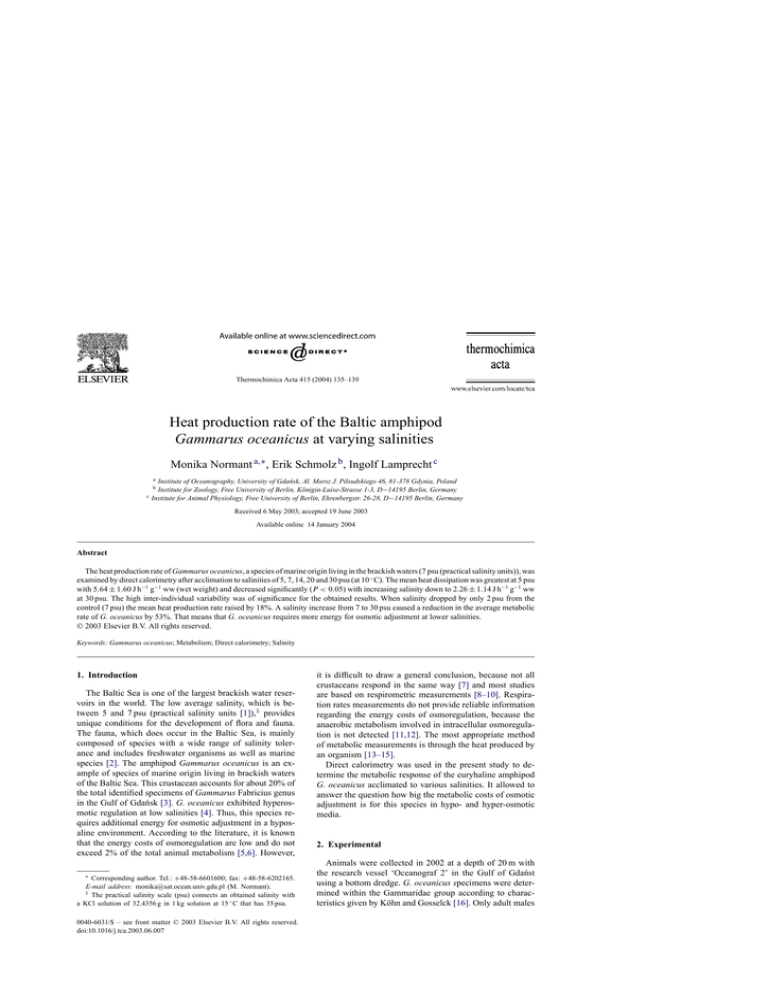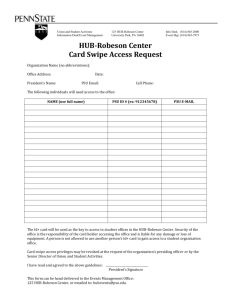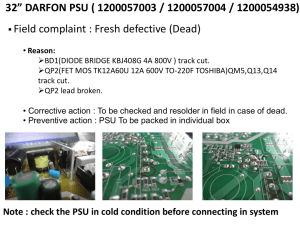
Thermochimica Acta 415 (2004) 135–139
Heat production rate of the Baltic amphipod
Gammarus oceanicus at varying salinities
Monika Normant a,∗ , Erik Schmolz b , Ingolf Lamprecht c
a
Institute of Oceanography, University of Gdańsk, Al. Marsz J. Piłsudskiego 46, 81-378 Gdynia, Poland
Institute for Zoology, Free University of Berlin, Königin-Luise-Strasse 1-3, D−14195 Berlin, Germany
Institute for Animal Physiology, Free University of Berlin, Ehrenbergstr. 26-28, D−14195 Berlin, Germany
b
c
Received 6 May 2003; accepted 19 June 2003
Available online 14 January 2004
Abstract
The heat production rate of Gammarus oceanicus, a species of marine origin living in the brackish waters (7 psu (practical salinity units)), was
examined by direct calorimetry after acclimation to salinities of 5, 7, 14, 20 and 30 psu (at 10 ◦ C). The mean heat dissipation was greatest at 5 psu
with 5.64 ± 1.60 J h−1 g−1 ww (wet weight) and decreased significantly (P < 0.05) with increasing salinity down to 2.26 ± 1.14 J h−1 g−1 ww
at 30 psu. The high inter-individual variability was of significance for the obtained results. When salinity dropped by only 2 psu from the
control (7 psu) the mean heat production rate raised by 18%. A salinity increase from 7 to 30 psu caused a reduction in the average metabolic
rate of G. oceanicus by 53%. That means that G. oceanicus requires more energy for osmotic adjustment at lower salinities.
© 2003 Elsevier B.V. All rights reserved.
Keywords: Gammarus oceanicus; Metabolism; Direct calorimetry; Salinity
1. Introduction
The Baltic Sea is one of the largest brackish water reservoirs in the world. The low average salinity, which is between 5 and 7 psu (practical salinity units [1]),1 provides
unique conditions for the development of flora and fauna.
The fauna, which does occur in the Baltic Sea, is mainly
composed of species with a wide range of salinity tolerance and includes freshwater organisms as well as marine
species [2]. The amphipod Gammarus oceanicus is an example of species of marine origin living in brackish waters
of the Baltic Sea. This crustacean accounts for about 20% of
the total identified specimens of Gammarus Fabricius genus
in the Gulf of Gdańsk [3]. G. oceanicus exhibited hyperosmotic regulation at low salinities [4]. Thus, this species requires additional energy for osmotic adjustment in a hyposaline environment. According to the literature, it is known
that the energy costs of osmoregulation are low and do not
exceed 2% of the total animal metabolism [5,6]. However,
∗
Corresponding author. Tel.: +48-58-6601600; fax: +48-58-6202165.
E-mail address: monika@sat.ocean.univ.gda.pl (M. Normant).
1 The practical salinity scale (psu) connects an obtained salinity with
a KCl solution of 32.4356 g in 1 kg solution at 15 ◦ C that has 35 psu.
0040-6031/$ – see front matter © 2003 Elsevier B.V. All rights reserved.
doi:10.1016/j.tca.2003.06.007
it is difficult to draw a general conclusion, because not all
crustaceans respond in the same way [7] and most studies
are based on respirometric measurements [8–10]. Respiration rates measurements do not provide reliable information
regarding the energy costs of osmoregulation, because the
anaerobic metabolism involved in intracellular osmoregulation is not detected [11,12]. The most appropriate method
of metabolic measurements is through the heat produced by
an organism [13–15].
Direct calorimetry was used in the present study to determine the metabolic response of the euryhaline amphipod
G. oceanicus acclimated to various salinities. It allowed to
answer the question how big the metabolic costs of osmotic
adjustment is for this species in hypo- and hyper-osmotic
media.
2. Experimental
Animals were collected in 2002 at a depth of 20 m with
the research vessel ‘Oceanograf 2’ in the Gulf of Gdańst
using a bottom dredge. G. oceanicus specimens were determined within the Gammaridae group according to characteristics given by Köhn and Gosselck [16]. Only adult males
136
M. Normant et al. / Thermochimica Acta 415 (2004) 135–139
of 15–24 mm size were chosen for experiments. They were
placed in an aquarium filled with water of the same temperature (10 ◦ C) and salinity (7 psu) as in the place of their
collection. Empty shells of the blue mussel Mytilus trossulus
were additionally placed in the aquarium to render natural
conditions. Gammarids were fed twice a week with soft tissue of M. trossulus. Specimens were acclimated to each of
five experimental salinities: 5, 7, 14, 20 and 30 psu (10 ◦ C,
oxygen saturation ca. 100%) in a step-wise way (2 psu per
day) up or down from the initial salinity (7 psu). Experimental media were prepared by diluting commercial sea salt
(hw-Meersalz, Wiegandt GmbH, Germany) with deionised
tap water. Animals were kept at appropriate salinity for 1
week before measurements.
Heat production rates were determined using an isoperibol twin calorimeter (Bioflux, Thermanalyse, France) with
vessels of 15 ml. The calibration factor of the calorimeter
was 40.7 V m W−1 . A single animal was transferred to a
vessel containing 12 ml of filtered (0.45 m pore size) and
well oxygenated water and of a proper salinity (at 10 ◦ C).
The calorimeter signal was continuously monitored by a
recorder (Linseis L6512, Germany) at a full scale sensitivity of 50 mV. Heat production measurements were carried
out for 1–2 h starting after an equilibration period. The oxygen content of the medium was determined before and after the experiment with a needle microelectrode (PA2000,
Unisense, Denmark). Then the length (millimetre) and wet
weight (gram) of each individual were determined. For easier transformation in usual metabolic data in biology, heat
production rates were expressed in joules per hour and gram
wet weight (J h−1 g-1 ww) and not in mW g−1 .
To compare data obtained at different experimental salinities a standardisation to 0.120 g wet weight was done using
an equation given by Navarro and Gonzalez [17]:
Ys =
Ws
We
b
Ye
where Ys is the heat production rate of an animal of standard
weight, Ws is standard weight of the animal (0.120 g), We is
observed weight of an animal, Ye is uncorrected (measured)
heat production rate and b is weight exponent for the heat
production rate (b = 0.68 for G. oceanicus, unpublished
data).
Linear (y = ax + b) and power regressions (y = axb ),
and correlation coefficients (R) were used to describe the
relationship between the investigated parameters. The significance of the obtained differences was tested using the
Mann–Whitney’s U-test at a significance level of 5%.
3. Results
The power–time curves of G. oceanicus varied according to the level of activity exhibited by the animals (Fig. 1).
Curves of type A, representing the heat production of resting animals, occurred sporadically. In most cases G. oceanicus showed locomotor activity during the measurements
with peaks of different sharpness. In many cases it was not
easy to distinguish between periods of rest and high locomotor activity. Thus, the total metabolic rate measured under the experimental conditions was the sum of both resting
and active rates. Animals exhibited high locomotor activity at 7 psu that ranged from 8 to 40% higher than resting
metabolism (on average 20 ± 9%) (Fig. 2). When particular
activity peaks were analysed, we found that up to 71% of
energy were used for locomotor activity.
A high inter-individual variability in heat production rate
was observed. The standard metabolic rate of amphipods of
the same wet weight differed significantly. Due to the high
inter-individual variability as well as to the different levels of activity exhibited a wide range of results were obtained for G. oceanicus at a given salinity. The highest values
varied from 2.04 to 8.34 J h−1 g−1 ww, with an average of
4.77±1.79 J h−1 g−1 ww at 7 psu (Fig. 3). On the other hand,
Fig. 1. Power–time curves of G. oceanicus exhibiting different levels of activities: (A) resting animal, (B) medium activity and (C) high activity.
M. Normant et al. / Thermochimica Acta 415 (2004) 135–139
137
Fig. 2. Contribution of the resting metabolic rate (black bar) to the total metabolism (100%) of 10 animals of G. oceanicus at a salinity of 7 psu.
Fig. 3. Mean specific heat production rates (±S.D.) of G. oceanicus under different salinities. Numbers inside the bars indicate the number of experiments.
Fig. 4. Percent change of the heat production rate of G. oceanicus after exposure to different salinities. An initial 100% value refers to the mean heat
production rate at the control (habitat) salinity of 7 psu.
138
M. Normant et al. / Thermochimica Acta 415 (2004) 135–139
-1 -1
Specific heat production rate (J h g ww)
y=0.95 ·x
-0.57
, R= -0.56
8
salinities:
5psu
7psu
14psu
20psu
30psu
7
6
5
4
3
2
1
0
0
0.05
0.10
0.15
0.20
0.25
Wet weight (g)
Fig. 5. Relation between the non-standardised mean heat production rate and the wet weight of G. oceanicus at different salinities. The solid line
represents the mean heat production rate as a function of the wet weight in the range from 0.06 to 0.24 g.
the lowest values spread from 1.48 to 3.67 J h−1 g−1 ww
with an average of 2.81 ± 0.68 J h−1 g−1 ww at 14 psu. The
mean heat production rate (p) was largest at 5 psu (5.64 ±
1.60 J h−1 g−1 ww) and decreased significantly with increasing salinity (s) following the equation p = 5.70 − 0.13 s
(R = −0.61, P < 0.05), reaching 2.26 ± 1.14 J h−1 g 1 ww
at 30 psu. Statistically significant differences (P < 0.05) in
the specific heat production rate occurred between the lower
(5 and 7 psu) and higher salinities (14, 20 and 30 psu). The
mean heat production rate at the highest salinity was about
60% lower than that at 5 psu. When the salinity dropped
only by 2 psu from the control value of 7 psu the mean heat
production rate raised by already 18% (Fig. 4), while an
increase in salinity from 7 to 30 psu caused a reduction of
53%.
Collecting all original, non-standardised values of the
mean specific heat production rate as function of animal
mass, we obtained a significant (P < 0.05) relation between
the non-standardised specific heat production rate (p) and
the wet weight (ww) of G. oceanicus that can be described
by the power function P = 0.95 ww−0.57 within the experimental range from 0.06 to 0.24 g (Fig. 5).
4. Discussion
Salinity is regarded as an important factor modifying the
metabolic rate of aquatic invertebrates. At least four different types of metabolic responses are known in marine and
brackish-water invertebrates [18]. G. oceanicus exhibited a
form of response that is typical for a large group of euryhaline invertebrates: its metabolic rate increased in subnormal
and decreased in supranormal salinities. This species is a
hyper-regulator and maintains its haemolymph osmolality on a level higher than that of the environment. Active
transport of Na+ and Cl− ions, which takes place against
a concentration gradient, requires energy expenditure [19].
Brodie and Halcrow [4] reported that the haemolymph
concentration of G. oceanicus reaches a new steady state
in a relatively short time of about 4 h after the change in
salinity. When the salinity decreased from 7 to 5 psu, the
difference in osmolality between haemolymph and environment increased from 153 to 239% for G. oceanicus from
the brackish waters of the Baltic Sea (unpublished data).
This may explain the high increase in the metabolic rate
between the two salinities. The energetic costs of osmotic
adjustment of G. oceanicus was highest under these conditions in agreement with our observations of a high mortality
of this species at salinities below 5 psu. At 30 psu, the
haemolymph osmolality of G. oceanicus is almost isoosmotic to that of the environment (unpublished data), so that
the amount of energy required for osmoregulation is minimal at these conditions. When juveniles of the lesser crab
Callinectes similis, a strong regulator, were collected at a
salinity of 29 psu and acclimated to 2.5 psu they showed a
maximum respiration rate twice as high as under normal
conditions [19]. The metabolic rate of G. oceanicus was
2.5 times higher at 5 psu than at 30 psu. The semiterrestric
fiddler crab Uca pugilator is adapted to live in cyclic salinity conditions under tide influence at the Atlantic Coast
and experiences increasing salinities due to evaporation and
decreasing ones due to dilution by rain. In both directions
the heat production rate grows up by more than 100%
[20].
The significant reduction in the metabolic rate of G.
oceanicus at higher salinities results from lower energetic
costs for the osmotic adjustment, but it might be intensified by differences in the oxygen content of these waters.
As oxygen solubility in water decreases with increasing
salinity [21], its concentration at 30 psu is ca. 15% lower
M. Normant et al. / Thermochimica Acta 415 (2004) 135–139
compared to 5 psu. It is known that the oxygen content
may considerably modify rates of both metabolism and
animal activity [22]. In our studies we observed that the
level of activity did not differ significantly in the range
of experimental salinities. There was also no relation between the activity level and the duration of the experiment.
High inter-individual variability in metabolic rates and
in the level of locomotor activity obscured the effects of
salinity on heat production rates. Thus, it is difficult to determine the energy metabolism capacity of G. oceanicus.
Similar conclusions were drawn by Liu et al. [12] when
studying the energy metabolism of the oyster drill Thais
haemastoma.
The weight dependence of the non-standardised specific
heat production rate presented in Fig. 5 exhibits an unexpected low exponent. It may result from the different activity states of animals during the calorimetric measurements.
It was shown in the literature that higher activity levels tend
to depress this exponent [23].
Kinne [18] wrote that many aquatic invertebrates respire
at the most economic rate in those salinities to which they
are genetically adjusted. Our studies are not in agreement
with this statement, because the mean metabolic rate of G.
oceanicus at the habitat salinity was among the highest rates.
But we do not know if there are other physiological mechanisms, which allow to compensate for the high energetic
costs required for osmotic regulation under low salinity. The
data obtained by Kolding [24] showed that two Baltic populations of G. oceanicus living at different salinities are genetically adapted to their local habitats. For example, G.
oceanicus from the Limfjord (Denmark) does not survive at
salinities below 20 psu. Guerin and Stickle [10] found also
that tolerance to salinity may differ between geographically
separated populations of the same species.
It is difficult to compare the obtained values with data
given in the literature because (i) investigated species were
of different origin, (ii) exhibited different mechanisms of osmotic regulation and (iii) different methods (mostly respirometric) or (iv) experimental conditions were applied by each
researcher. The total metabolic rate of G. oceanicus at habitat salinity was similar compared to an other brackish water species Gammarus tigrinus, which is characterised by
4.7 ± 1.2 J h−1 g−1 ww [25]. Heat dissipation of G. tigrinus increased by 72% after transfer to a K+ pollution of
10 mM l−1 . Such a response is typical and results from the
high energy cost of osmotic adjustment in the initial phase
of a salinity stress.
139
Acknowledgements
We would like to thank Mr. Tomasz Lapucki from Gdańsk
University for help in sample collection and Mr. Assegid
Garedew from Free University of Berlin for his assistance
during the experiments. This research has been supported by
a Marie Curie Fellowship of the European Community programme Human Potential to M.N. under contract number
HPMF-CT-2001-01478 and by grant no. 0448/P04/2001/21
from the Polish Ministry of Scientific Research and Information Technology.
References
[1] UNESCO, Tenth report of the joint panel on oceanographic tables
and standards, Unesco Technical Papers in Marine Science, 1981,
p. 37.
[2] G. Hällfors, A. Niemi, A. Ackefors, H., Lassig, J., E. Lappäkoski,
in: A.Voipio (Ed.), The Baltic Sea, Elsevier Scientific Publishing
Company, Amsterdam, Oxford, New York, 1981, p. 219.
[3] W. Jeczmien, A. Szaniawska, Oceanologia 42 (1) (2000) 71.
[4] D.A. Brodie, K. Halcrow, Experientia 34 (10) (1978) 1297.
[5] Schmidt-Nielsen, K, Animal Physiology, Adaptation and Environment, Cambridge University Press, Cambridge, 1983, p. 730.
[6] P. Willmer, G. Stone, J. Johnston, Environmental Physiology of
Animals, Blackwell Science, Oxford, 2000, p. 644.
[7] S.D. Roast, J. Widdows, M.B. Jones, Mar. Biol. 133 (1999) 643.
[8] S. Einarson, Mar. Biol. 117 (1993) 599.
[9] S.G. Cheung, Mar. Biol. 129 (1997) 301.
[10] J.L. Guerin, W.B. Stickle, Mar. Biol. 129 (1997) 63.
[11] W.T. Potts, G. Parry, Osmotic and Ionic Regulation in Animals,
Pergamon Press, Oxford, 1964, p. 423.
[12] L.L. Liu, W.B. Stickle, E. Gnaiger, Mar. Biol. 104 (1990) 239.
[13] M.M. Pamatmat, Mar. Biol. 48 (1978) 317.
[14] I. Lamprecht, Pure Appl. Chem. 70 (3) (1998) 695.
[15] I. Lamprecht, E. Schmolz, in: R.B. Kemp (Ed.), Handbook of Thermal Analysis and Calorimetry, Vol. 4: From Macromolecules to Man,
Elsevier Science, Amsterdam, 1999, p. 405.
[16] J. Köhn, F. Gosselck, Mitt. Zoolog. Mus. Berl. 65 (1) (1989) 3.
[17] J.M. Navarro, C.M. Gonzalez, Aquaculture 167 (1998) 315.
[18] O. Kinne, (Ed.), Marine Ecology, A Comprehensive, integrated Treatise on Life in Oceans and Coastal Waters, Vol. 1, Environmental
Factors, Part 2, Wiley-Interscience, London, 1971, p. 1244.
[19] A. Pequeux, Belgian J. Zool. 124 (1) (1994) 49.
[20] G.B. Joachimsohn, I. Lamprecht, K. Graszynski, Thermochim. Acta
94 (1985) 151.
[21] H.E. Garcia, L.I. Gordon, Limnol. Oceanogr. 37 (1992) 1307.
[22] O. Kinne, Oceanogr. Mar. Biol. Ann. Rev. 2 (1964) 281.
[23] C.R. Bridges, A. Brand, Mar. Ecol. Prog. Ser. 2 (1980) 133–141.
[24] S. Kolding, Mar. Biol. 89 (1985) 249.
[25] J.H.E. Koop, J. Zange, M.K. Grieshaber, Thermochim. Acta 251
(1995) 45.




